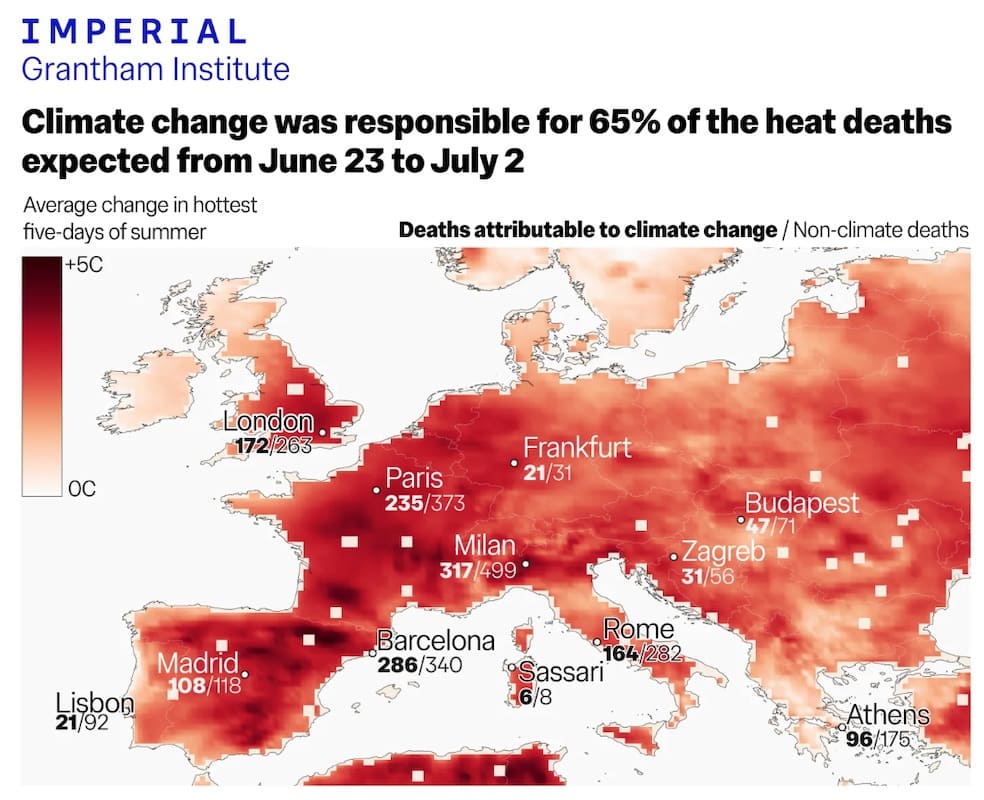
The estimated toll from recent heatwaves across European cities has surpassed that of many recent disasters.
Last week, climate change tripled the number of heat-related deaths in Europe. According to the first rapid attribution study on heat mortality, the extreme heat driven by global warming led to around 1,500 additional heat-related deaths in 12 European cities.
Between late June and early July, Europe experienced severe heat, with temperatures soaring above 104°F (40°C) in several countries. The extreme heat cut outdoor working hours in Italy, forced France to close over 1,300 schools, led Switzerland to shut down a nuclear reactor, and triggered wildfires in Greece, Spain, and Turkey.
Fossil fuels and climate change
Fossil fuel use and deforestation have intensified climate change, making the recent heatwave significantly hotter, with temperatures 1 to 4°C higher than they would have been otherwise. Researchers warn that such heatwaves are becoming alarmingly frequent in European cities, although they should occur only once every two to five summers.
The study exposed the fatal consequences of fossil fuel dependence. Focusing on the 10-day period from June 23 to July 2, scientists used peer-reviewed methods to estimate deaths and concluded that climate change tripled the number of fatalities caused by heat.
The rise in temperature, reaching up to 4°C in all cities examined, directly links fossil fuel emissions to the spike in mortality. Of the estimated 2,300 heat-related deaths in Europe, nearly 1,500—or 65%—were attributed to climate change.
Ben Clarke from the Centre for Environmental Policy at Imperial College London commented, “Heatwaves don’t leave behind visible devastation like fires or storms. Their impact is mostly invisible but silently catastrophic. A difference of just 2 or 3°C can mean life or death for thousands. Our study shows how dangerous climate change already is at just 1.3°C of warming. But we could reach 3°C this century unless countries accelerate the shift from fossil fuels to renewable energy.”
A worsening trend
Scientists warned that heatwave temperatures will continue to rise, with future death tolls likely to be even higher. Their message is clear: as long as the world keeps burning oil, gas, and coal at high rates, heat-related deaths will keep climbing and net-zero emissions will remain out of reach.
This marks the first rapid study estimating climate-related deaths from a heatwave, led by scientists from Imperial College London and the London School of Hygiene & Tropical Medicine.
Researchers used historical mortality data to calculate the impact. The study described heatwaves as “silent killers” since most heat-related deaths go unreported. Official government figures may take months to be released, if they are published at all.
Heat-related deaths across Europe

The study found that climate change was responsible for an estimated 317 excess deaths in Milan, 286 in Barcelona, 235 in Paris, 171 in London, 164 in Rome, 108 in Madrid, 96 in Athens, 47 in Budapest, 31 in Zagreb, 21 in Frankfurt, 21 in Lisbon, and 6 in Sassari.
These figures suggest that the heat-related death toll linked to climate change in many cities surpassed that of other recent disasters, such as the 2024 floods in Valencia (224 deaths) and the 2021 floods in northwestern Europe (243 deaths).
Older adults, especially those over 65, accounted for 88% of the climate-related deaths, highlighting how vulnerable individuals with pre-existing conditions are at the greatest risk of dying during heatwaves. Even modest increases in temperature can overwhelm their systems, with catastrophic results.
Long-term solutions needed
The study also acknowledged the progress made in Europe in developing heat action plans. However, to truly protect people from increasingly deadly heatwaves, long-term strategies are essential. These should include reducing the urban heat island effect, expanding green and blue spaces, and ensuring access to cooling centers and formal support systems for the most vulnerable.